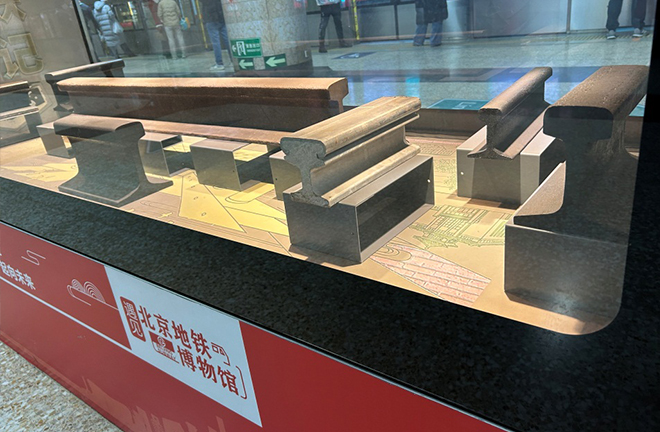Forum eyes BTH coordinated development

Rail parts displayed at the Beijing Subway Museum Photo: Yang Lanlan/CSST
A forum on the 10th anniversary of the implementation of the Beijing-Tianjin-Hebei (BTH) coordinated development strategy, hosted by the Beijing Academy of Social Sciences (BASS), recently took place in Beijing.
A decade of development
Shi Dan, director of the Institute of Industrial Economics at the Chinese Academy of Social Sciences, summarized the achievements of BTH coordinated development over the past decade into six aspects: the dispersal of Beijing’s non-capital functions, industrial alignment and cooperation, transportation integration, ecological governance and protection, convenient sharing of public services, and collaborative innovation.
The comfort level of human settlements is an important indicator for gauging urban development. Fang Chuanglin, an academician of the International Eurasian Academy of Sciences and a research fellow from the Institute of Geographic Sciences and Natural Resources Research at the Chinese Academy of Sciences, used the “beautiful city clusters” assessment system to vertically measure the changes in the BTH urban cluster over the past decade. From the perspective of geographical sciences, the “comprehensive beauty index” encompasses factors such as fresh air, clean water, favorable ecology, soil safety, and hygienic living conditions to evaluate the evolution of aesthetically pleasing urban agglomerations and the extent of goal attainment. In the past 10 years, the comprehensive beauty index of BTH city clusters has increased from 54.4 to 76.98, reflecting an average annual growth rate of 3.53%, and attaining a commendable rating. The construction of BTH urban clusters has made historic progress, achieving high-quality socio-economic development and harmony between human and nature.
Li Xiaojiang, former president of the China Academy of Urban Planning and Design, said that the practice of the BTH coordinated development strategy has played a guiding role in propelling the transition of coordinated development in this region and driving the fundamental transformation of the governance and construction methods of other mega-cities in China.
Ways forwards
To transform the BTH region into a pilot and demonstration zone for Chinese modernization, Liu Binglian, director of the Institute of Beijing-Tianjin-Hebei Coordinated Development at Nankai University, advocates for the integration of regional development with the broader modernization agenda. The new task of BTH coordinated development is to establish a leading area for world-class urban agglomerations in densely populated areas by elevating the level of economic development, forging a new situation of coordinated opening up. The main “skeleton” of world-class urban agglomerations needs to be framed by the optimization of new spaces and the construction of megalopolises.
The proposed strategy of BTH coordinated development builds upon the natural complementary advantages of the three regions, with their close geographical proximity offering unique conditions for the mutual transformation of resources. Despite this, the key lies in leveraging Beijing’s technological innovation advantages in Tianjin and Hebei, driving economic growth with industrial coordination and generating the synergies of “1+1+1>3.”
Chen Wenling, chief economist of the China Center for International Economic Exchanges, likened the image of “industrial synergy” to using the two wheels of Beijing and Tianjin to drive the chassis of Hebei. To fully unleash the industrial transformation effect of Beijing’s rich scientific and technological innovation resources, it is vital to enhance the industrial and innovation coordination of the three places. This calls for shifting the existing consultation and conference cooperation mechanism into stable, long-term innovation, industrial, capital, and talent chains.
With the proposal of the concept of new quality productive forces, attendees agreed that the BTH region should also seize this opportunity to set new development goals. Wu Yiqing, former vice president of Hebei University of Economics and Business, stressed the necessity of leveraging Beijing’s advantages in technological innovation to develop new quality productive forces and activate industrial innovation, enhancing the transformation efficiency and ratio of scientific achievements. Wu also suggested centering the industrial chain around new quality productive forces, accelerating special actions for advanced manufacturing clusters, and establishing cross-regional collaborative cultivation mechanisms for the clusters. These efforts are aimed at constructing world-class advanced manufacturing clusters in the region.
Zhao Hong, former vice president of BASS, said that the BTH coordinated development strategy is implemented through the construction of a modern capital metropolitan area, which will prioritize catering to the demand for “one-hour commuting circles.” The foremost requirement of residents living in a megacity like Beijing is convenience in both work and life. Therefore, meeting the intense traffic demand between different functional areas and smoothing regional linkages throughout the city represent breakthrough points regarding BTH coordinated development. Further emphasis should be placed on the development of the “one-hour commuting circle” to rationalize the metropolitan spatial structures through the implementation of suburban railway.
Edited by YANG LANLAN
